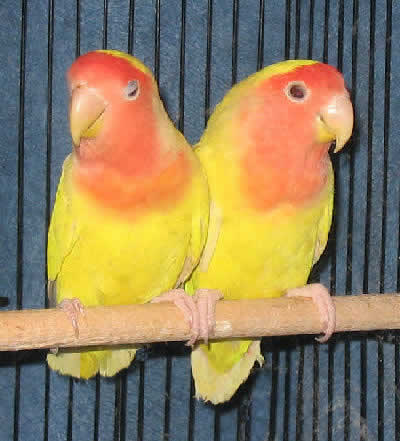 Lutino Peach-faced Lovebird
Lutino Peach-faced Lovebird
Family: Psittacidae
Scientific Name: Agapornis roseicollis var.
Description:
The Lutino Lovebird, a particularly striking bird with an overall yellow coloring and a bright red face, is a mutation of the Peach-faced Lovebird. The lutino mutation is a sex-linked gene. It acts by removing removing all of the melanin, the dark pigment, from the bird while the pigments of yellow and red are uneffected. There are two other sex-linked mutations which work to partially remove or dilute the melanin. They are called cinnamon, or sometimes 'fallow'. The darker of the two is the American cinnamon and can be described as a light green. The other is the Australian cinnamon, which is a very light greenish-yellow.
Size - Weight:
The Lutino Lovebird will get up to about 6" - 7" (16 - 18 cm) in length.
Care and feeding:
A roomy cage is required as lovebirds are very active. If you have a tame pet that is kept in a small cage, it needs to be let out for extended periods to fly about. Your pet they will enjoy a variety of seeds, fruits, vegetables, and commercial pellets.
Social Behaviors:
A lovebird is a very social bird with it's companion, and it is generally thought to be essential for their good health and happiness that they be kept in pairs rather than singly. They can, however, be aggressive towards other birds in an aviary setting.
Activities:
Loves to fly, climb, and play. Provide lots of room and lots of toys.
Breeding/Reproduction:
The Lutino Lovebird is excellent for the beginning breeder. These birds will breed well in either colonies or in a single pair, and have the same behaviors as the Peach-faced Lovebird. When you provide them with a nest box, be sure to also provide lots of willow twigs, palm fronds, or other nesting materials as they will build a small nest of their own inside of the nest box. They will carry the nesting materials between their back and rump feathers. The hen will lay four to five eggs which are incubated for about 23 days. The young fledge (leave the nest) in about 30 to 38 days but will still be dependent until about 43 days. When they become independent, remove the young to their own housing. See About Lovebirds: Breeding/Reproduction for more information on breeding.
Potential Problems:
This bird has a moderate but metallic shriek and can be somewhat noisy for parts of the day. See About Lovebirds: Potential Problems for information on illnesses.
Source: http://animal-world.com/encyclo/birds/lovebirds/lutinolovebird.php
Author: Clarice Brough, CAS
Photo © Animal-World: Courtesy David Brough



0 comments:
Post a Comment